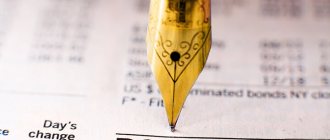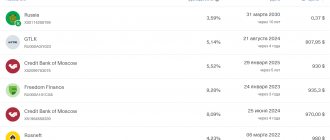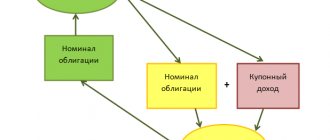Features of duration
The word entered the Russian language and was transformed from the English duration (duration). Indicates the average time (in years or days) during which an investor will fully return his investment in a bond.
Duration is not the same as maturity. In terms of the number of days, it may be equal to the repayment period, or it may be shorter than it. The duration is affected not only by the maturity date, but also by the issuer's coupon policy: whether it pays coupons, how often and in what amount.
- The more often and more coupons are paid, the shorter the duration: the bond holder will quickly return the money that he invested in the purchase of this bond.
- If coupons are not paid, then the investment will be returned only at the end of the maturity period (when the issuer redeems its security) - in this case, the duration in the number of days is equal to the maturity date.
A little about banks and loans
By the way, the above examples fully explain why banks give loans and demand repayment of the debt with interest every month.
As you understand, this is one of the main ways to minimize the risks of non-return. Why give a loan with the condition of returning the full amount with interest at the end of the term? And wait several years, when you can immediately receive borrowed funds in installments.
The interest rate on loans issued works similarly. It varies for each client. Unreliable (from the bank's point of view) borrowers receive loans with higher interest rates. Compared to the solvent flow of regular customers.
The risk of non-return in the first case is much higher. And in order to approximately balance the risks of loans issued in both categories of borrowers, banks raise rates (reduce risks) for the unreliable category.
By converting to bonds, which are promissory notes or a loan that you give to the issuer issuing the paper, we get.
When the loan rate (coupon) increases, the bank’s risks and, accordingly, duration are reduced.
Calculation
To calculate duration, a complex formula is used. But to understand the logic, we will simplify it and make a calculation using three examples with the same profitability.
- Let's calculate the duration for a bond with a par value of 1000 rubles, a maturity of 1 year and a coupon of 50 rubles, which is paid every 6 months (i.e. we will receive 50 rubles in 0.5 years, and after 1 year we will receive 50 rubles + 1000 rubles face value). The receipt on the bond, multiplied by the time of receipt, is divided by the amount of the total receipts on the maturity date (in our example, this is the face value of 1000 rubles and the amount of coupons is 100 rubles). We calculate: 0.5 years * 50 rubles + 1 year * 1050 rubles / 1100 rubles = 0.97 years
- The repayment period is 1 year, the par value is 1000 rubles, but coupons are paid 4 times a year for 25 rubles (after 0.25 years, after 0.5 years, after 0.75 years and every other year along with the par value). We calculate the duration: 0.25 years * 25 rubles + 0.5 years * 25 rubles + 0.75 years * 25 rubles + 1 year * 1025 rubles / 1100 rubles = 0.96 years
- The repayment period is 1 year, the denomination is 1000 rubles and there are no coupons. But on the maturity date we receive a one-time payment of 10% of the face value (100 rubles). We calculate the duration: 1 year * 1100 rubles / 1100 rubles = 1 year
.
The examples show that (other things being equal) the more often coupons are paid, the shorter the duration. The bond holder returns the money invested faster. The faster he returns the money, the less risks associated with changes in the market value of securities.
Duration and inflation
Let's look at the essence of duration using an everyday example. Two friends ask you to borrow 100,000 rubles each. Both promise 20% per annum, so by the end of the term you should receive 120,000 rubles from each. Return conditions are different:
- One pays 10,000 rubles every month for the whole year.
- Another returns all 120,000 rubles at the end of the year (as above in example 3 with a bond).
In the first case, you start receiving money almost immediately - the duration is shorter. And in the second case, the duration is equal to the maturity of the debt. Let us remember the fact of inflation: time depreciates money. Therefore, 120,000 rubles today are worth more than 120,000 rubles in a year. Due to inflation, it is more profitable to receive debt in installments. And the more often partial payments are made during the year (repayment period), the more profitable it is.
Examples of what it is needed for and where it is used
Duration allows you to assess the riskiness of investments. The main goal of the investor is to minimize the risk of losses while maintaining the required level of profitability.
Considering that there are many securities circulating on the debt market with different circulation periods, yields and different coupon payments, we need some parameter that can compare them.
One of them is duration.
For a better understanding, let’s look at examples of their real life.
Example 1.
You are asked to borrow 100 thousand rubles at 10% per annum for a year by 2 people: Ivan Petrovich and Uncle Vasya.
Ivan Petrovich offers to pay you interest for use every month. And return of the entire debt amount at the end of the term.
Uncle Vasya cannot pay monthly. But he promises to return the entire amount with interest in a year.
Who would you lend money to?
The answer is obvious. Of course, Ivan Petrovich.
And why? You immediately start making profits in the first month. And the risk that the debt will not be repaid in full or in part is also lower.
Duration works the same way. If the yield of 2 securities (with the same credit rating) is the same, we choose the bond with the lowest duration.
Example 2.
Ivan Petrovich and Uncle Vasya want money again. Again 100 thousand at 10% per annum. Only Ivan Petrovich asks to give him a loan for 3 years. And Uncle Vasya for 10 years. Both agree to pay interest every quarter.
Another question. Which one should you lend?
By lending to Ivan Petrovich, you will get your money back faster. This means there are fewer risks. Over a 3-year period, the likelihood of various situations arising that affect the value of money is much lower.
By lending to Uncle Vasya for such a long period of time, you risk more. There is no telling what might happen in this decade.
Suddenly, in 5 years, severe inflation will begin in the country and all your borrowed funds will immediately depreciate. Or there will be an increase in the interest rate in the country. When the interest rate is below 20-30% per annum, no one will lend. And your profitability from Uncle Vasya for this period of time will be simply ridiculous. Uncle Vasya may get sick, lose his job, or simply not want to repay your debt.
By borrowing money for 3 years, we bear much less risk of loss in the future.
And again, duration shows this whole thing. According to Uncle Vasya, it will be much larger.
How changes in interest rates affect bond prices
The dynamics of market prices for bonds largely depends on changes in interest rates. At the same time, there is an inverse relationship: when rates rise, the market price decreases, and when rates fall, it increases.
This dependence is not always equivalent. For example, if rates fall by 5%, the value of the security may rise by the same 5%. If rates rise by 5%, the bond will fall in price by 4%.
The key rate of the Central Bank has a decisive influence on the yield of debt obligations. If the key rate increases, coupon bonds fall in price. When the key rate falls, the market value of such securities increases.
The monetary duration formula (according to Macaulay) does not take into account changes in rates. To calculate the payback period of investments at variable rates, it is better to use the indicators of effective duration and modified duration of bonds.
Formula
Duration is calculated using the formula:
D – duration; n – number of payments; t – period required for full repayment; M – repayment of the nominal price of the bond; C – cash receipts of interest income; i – discount rate; p – market price of the bond.
Virtually all of these calculations are currently performed automatically. By registering on specialized online brokerage resources or simply viewing data on certain securities, the investor already sees the final value of duration.
Where to buy paper
You can buy bonds using the services of brokers or through a management company. The brokerage company will create a personal account for you and help you with installing the program and choosing paper. Apart from the commission, you will not have to pay anything else. And if you want to resell the bonds after some time, then the commission will be minimal.
If you have no desire to deal with the applications, then I advise you to contact the Criminal Code. You purchase part of a portfolio of securities of some companies, and the manager monitors all changes. The commissions here are much higher than at a brokerage agency.
Best brokers
You need to take the choice of a broker seriously, so below I attach a comparative table of the best brokerage companies:
Rick Keith Opening CapTrader Exante
The oldest Russian broker, operating since 1994. An excellent choice for those who want to connect to autofollow. Pros:
- no annoying calls with offers to spend money;
- own trading platform;
- impressive results of strategies (+74% for 2022) that you can connect to.
Of the minuses:
- no Quik.
You can read the full review here.
A good broker for a beginner. Here I hold the Russian part of the investment portfolio from an ETF from FinEx on an IIS.
The broker pleases:
- low commissions and the absence of annoying calls with offers to spend my money.
Of the minuses:
- weak personal account and inconvenient system for annual key regeneration.
The review can be read here.
Another great broker with whom I worked for more than 2 years. This is where I traded on FORTS.
Pros:
- Reasonable commissions
- Excellent personal account
- Nice free services
The downside is the broker's love of calling people trying to sell something.
The review can be viewed here.
German IB introducing broker for direct access to foreign markets. This is where my investment portfolio is located.
Pros:
- Works with Russians
- Availability of a Russian-language version of the site
- Reasonable commissions
- No inactivity fee
- Insurance under US law for $500k
The disadvantages include:
- Support exclusively in English and German
- The support service itself is poor
For a detailed review, see this post.
Another interesting broker for going abroad, and not from the IB family. Unfortunately, contracts are opened for Russians only in Cyprus.
Pros:
- Acceptable commissions
- The fact of successful verification of work by the SEC
- Russian-language website and support
On the downside:
- Cyprus jurisdiction
- Inactivity fee
Read a detailed review here. You can get a $500 bonus when opening an account here.
Effective duration and offer
A more accurate formula is the effective duration of bonds, which takes into account changes in the interest rate both up and down. This formula is suitable for bonds with an offer, for which there is an option to repurchase before maturity.
\[ D_e=\frac{P_{i-} – P_{i+}}{P_0*(i_+ – i_-)} , where \]
\( P_{i-} \) - market price in case of a rate decrease;
\( P_{i+} \)- market price in case of rate increases;
\( P_0 \)– initial price;
\( i_+ \)- size of the increased bet;
\( i_- \) - the size of the reduced rate.
Let's assume that the rate can change by 2% up and 3% down. Then, using the previous calculations, we get:
\( P_{i+} \)=25-(25*1.39*2/100)=1,826 rub. ($24.34 or 706 UAH);
\( P_{i-} \)=25+(25*1.39*3/100)=1,953 rub. ($26.04 or 755 UAH);
\( i_+ \)= 12%;
\( i_- \)= 7%.
\[ D_e=\frac{26.04-24.34}{25*(12-7)}=0.01 \]
A value close to zero indicates low sensitivity of the market value of a debt obligation to changes in interest rates. In simple terms, low duration is an indicator of low risk.
Accordingly, a bond with a longer duration represents higher risk and a longer payback period.
This formula should be used if the government is preparing decisions to change the Central Bank rate.
Who coined the term and when?
@npg.org.uk
The category of duration refers to the field of economic theory and practice, the author of this concept is the American economist Frederick Macauley. As part of his research, the economist came to the conclusion that duration acts as the most optimal format for calculating the time element of a security. Afterwards, this term began to be actively used in economic practice, gradually moving into other areas, including investment.
Let's summarize
Duration itself is numbers, nothing more. Its usefulness is in filtering securities for purchase, if, under equal conditions, it is necessary to make a choice in favor of lower risk or high potential profit. For example, there is a desire to invest in federal loan bonds for 10 years. There are several dozen of them on the market with different coupons and market prices. At first glance, it is worth paying attention to the current profitability: the higher it is, the more profitable it is for us.
But! You may find that a security is always redeemed at par at the end of its circulation period. Moreover, if the current market value of the bonds greatly exceeds the face value (for example, by 500 rubles with a face value of 1000), then when the securities are redeemed, the investor faces a loss on this difference (- 500 rubles). And all the higher returns will be eaten up.
In order to skillfully work in the stock market, you need to know a number of rules:
- the duration of a non-coupon bond is always equal to its term to maturity;
- coupon debt securities have a duration less than their circulation period;
- the shorter the duration, the lower the risks;
- bonds with high duration react more strongly to changes in interest rates in the future, which leads to changes in their market value;
- When predicting a decrease in interest rates in the future, securities with a long duration have the highest returns.
Pay attention to this. If there are prerequisites for an increase in interest rates, your preference should be given to securities with minimal duration. They are the ones who react least to changes in market prices. At the same time, the duration can change daily: the refund period is reduced! A high level of coupon payments can reduce duration due to a faster return on investment. Low – on the contrary, everything increases.











